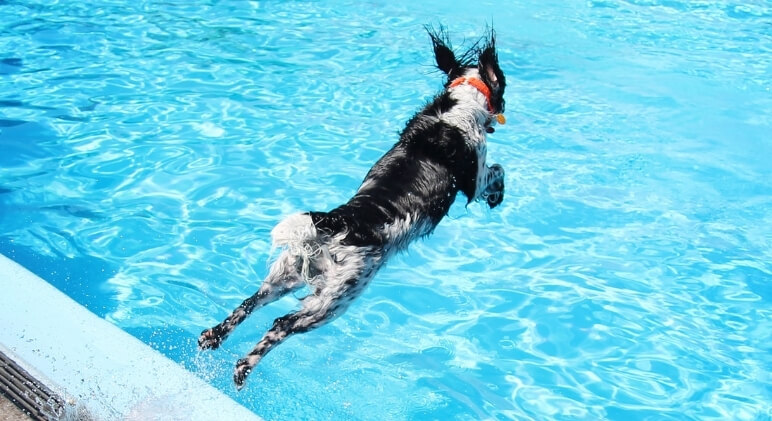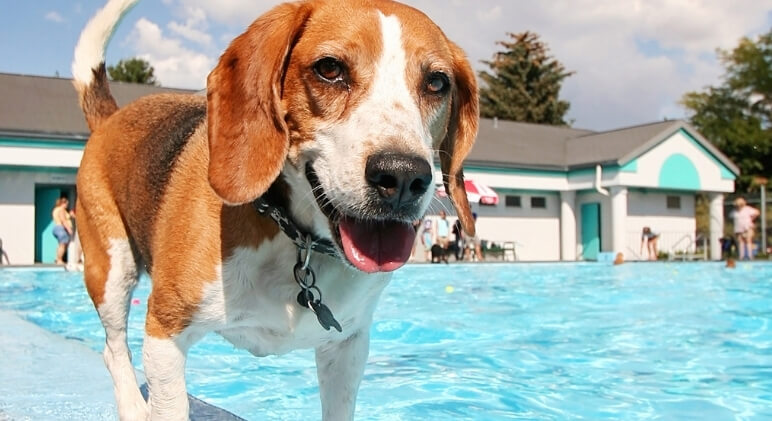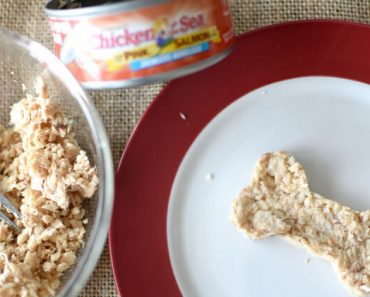Nothing is more refreshing on a hot summer day than taking a dip in the pool. And if you have a water-loving dog then you may have considered welcoming your pup into the water with you. But are pools even safe for dogs? Can the chlorine hurt them? What if they accidentally drink pool water? And how can we keep our canine companions safe while doing the doggy paddle? Read on as we share important pool safety tips for dogs!
Is Chlorine Safe For Dogs?
A lot goes into maintaining a swimming pool. You need to regularly test the water’s pH, add chlorine tablets to keep the water properly balanced, and occasionally shock it with stronger chemicals to keep bacteria, algae, fungus, and parasites away!
Here’s the good news: Chlorine levels in a properly balanced pool are pretty low, and considered safe for dogs to swim. A quick rinse after your dog’s dip will help wash away any leftover chlorine and reduce the risk of skin irritation or dryness.
If the water is properly maintained and your dog winds up accidentally ingesting a small amount of pool water, don’t panic. They should be just fine. But, in general, always keep a bowl of fresh water nearby so Fido can stay hydrated, and discourage them from lapping up any pool water. Ingesting excess amounts of chlorinated water can irritate a dog’s GI tract, lead to nausea, vomiting, and even damage their esophagus.
Risks are greater if the chlorine balance is either too high or too low. Yes, you read that right … low levels of chlorine are also an issue, as it can lead to a variety of unwanted microorganisms in the water. So, before letting your pup take a dip, bust out the test strips and check to ensure your pool chemicals are in proper balance.

Additionally, store chlorine tablets and other pool chemicals in a safe place, out of your pup’s reach. Dogs may be able to tolerate the low levels of chlorine in pool water, but they’ll need emergency attention if they get into your stash of harsh chemical cleaners.
What About Salt Water Pools?
If you have a saltwater pool, Fido can still enjoy an afternoon dip. In fact, saltwater pools may be gentler on your dog’s skin. With that said, it’s still a good idea to rinse him off with a hose afterward!
If your dog accidentally ingests a small amount of saltwater, he should be okay. But, just like with chlorinated water, drinking excess amounts from a saltwater pool can lead to digestive upset. Given the salt content, it can also trigger electrolyte imbalance While pool water contains significantly less salt than ocean water, drinking large amounts of pool saltwater can be life-threatening.

6 Swimming Safety Tips
Not all dogs are natural-born swimmers and comfortable in the water. So, when welcoming your canine companion into the pool, take things slow and be mindful of your dog’s limits.
- Supervise: Whether this is your dog’s first time in a pool or they’re a seasoned swimmer, always supervise your dog when in or around the pool.
- Get a Life Vest: They make life vests specifically for dogs and this small investment could be a huge lifesaver! The Outward Hound’s life vest has wonderful ratings. Available in five sizes, ranging from XS-XL, more than 4K people have already shared positive reviews on Amazon. It’s even earned an “Amazon’s Choice” badge!
- Start Slow: All dogs — even breeds designed to thrive in water — tend to be afraid the first time they go into the pool. Never throw your dog into the water or force them to swim if they don’t want to. Instead, encourage them to explore the water, offering lots of praise every step of the way. You can even bring some of their water-safe toys into the pool to make it more appealing.
- Familiarize Your Pup With The Pool: When teaching your dog to swim, The American Kennel Club recommends first carrying your dog into the pool (staying in shallow waters and close to the steps), gently setting him into the water, and then letting him swim to the steps (keeping your hand under your pup’s belly for guidance until he finds his balance). Reward with lots of praise and repeat this process several times, until he gets more comfortable.
- Ladder/Stairs Training: Teaching your dog how to exit the pool is essential. If your pool only has a small, verticle ladder then it may be difficult for your dog to climb. But, it’s still important to teach your dog where to exit. A set of dog-friendly pool stairs like THESE or a beach entry pool will make this process much easier for dogs to enter and exit.
- Go at Your Dog’s Pace: Swimming can be a lot of fun, but it’s also an exercise. Your dog will use new muscles and may get tired quickly. So, keep swim sessions short, and don’t let your dog overdo it.

Post-Swim Tips
Rinse Off: As I mentioned above, rinse your dog off with fresh water after a dip in the pool to wash off the chemicals and reduce the risk for irritated and dry skin.
Post-Swim Ear Routine: Gently dab your dog’s ears with a towel to reduce the risk of ear infection.
Speaking of keeping your dog safe, check out these step-by-step instructions for giving your dog CPR. Hopefully you’ll never need it, but it’s still important to know!

How Dogs Can Affect Pools
If your pool has a vinyl or plastic liner then be mindful that claws can quickly cause damage, leading to an expensive repair.
Additionally, dog hair, dander, and dirt from their paws will enter the pool. Make sure to clean out pool skimmers and filters to avoid clogs.








